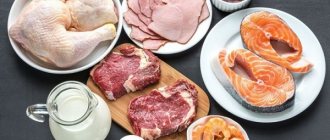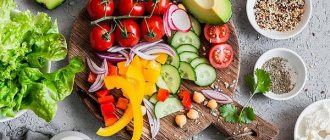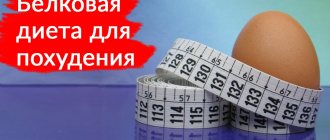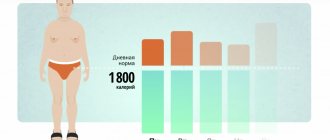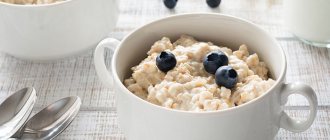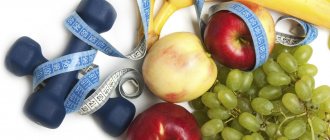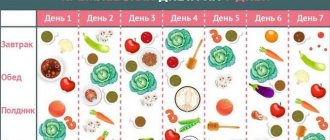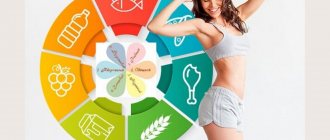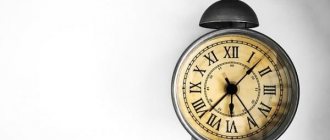Being fit and athletic is the trend of our time. But what to do if you don’t have enough time for sports, or it doesn’t bring you pleasure, or your weight is such that decent physical activity is simply contraindicated? A diet, that is, a restrictive eating regimen, will come to the rescue.
Diet is a multifaceted tool that can be used to achieve various goals. Gain or lose weight, build muscle tissue, get rid of the symptoms of any diseases, shorten the recovery period after surgery - this and much more can be done with a diet!
Types of restrictive nutrition
To get rid of extra pounds, nutrition systems are used:
- no carbohydrates;
- low carb;
- low fat;
- low-calorie.
The names speak for themselves. And any diet one way or another belongs to the categories mentioned above. Their action is based either on a lack of some element (fats, carbohydrates), or on a decrease in the daily calorie content of food.
Separately, there are “one product” diets, in which a person eats only one type of food for several (1-2, rarely more) days: soup, juices, kefir, apples, etc. They work due to the fact that the body receives only certain and always the same nutrients. He has to get the rest from his bins.
Quitting the diet
Losing weight on this nutrition system is quite simple, but it is much more difficult not to gain it again later. Often women, after a protein-fruit diet, gain weight again due to the fact that they again begin to consume excess amounts of food. In some cases, the newly gained weight even exceeds what it was before losing weight.
After finishing the protein-fruit diet, it is recommended to begin a smooth exit from it. First, you can add foods containing complex carbohydrates to your breakfast, for example, buckwheat porridge and a piece of whole grain bread. After a few days, if the weight has not increased, then you can eat meat with a side dish for lunch.
The essence of the method
The fruit-protein diet is a protein-based weight loss method. You can eat lean protein foods, alternating them with fruits and vegetables, but without mixing one with the other. Portions are small, meals are split, 5-6 (sometimes 7) times a day.
What is the main idea? The fact is that when there is a lack of carbohydrates, the body switches to using protein and fat as fuel. There is little fat coming in, so you have to spend “savings”. There is a lot of protein, but it is a building material and is used for muscles and other needs of the body. Why, then, these fruits and vegetables, if there should not be enough carbohydrates?
Then, they carry a wide range of vitamins and other essential elements. And in addition, they contain fiber, without which the gastrointestinal tract does not function properly.
According to reviews, the effectiveness of the fruit-protein diet is extremely high. And hunger can be avoided due to a good supply of protein products. However, this diet is not without its drawbacks. Firstly, it is not suitable for everyone; there are health restrictions. Secondly, any poor diet can lead to unforeseen consequences and cannot be maintained for long. That is, when the weight is too heavy, you will have to lose it in several stages with breaks.
Authorized Products
The basis of the fruit-protein diet is:
- Protein products - lean varieties of red meat, chicken egg whites, poultry meat (chicken, turkey), rabbit meat prepared by boiling/baking or steaming, seafood, fermented milk/dairy products of minimal fat content, low-fat sea/river fish.
- Unsweetened fruits - baked sweet and sour apples, oranges, avocados, cherries, kiwi, grapefruit, tangerines, nectarines, lemons, mangoes, feijoa, pomelo, plums, cherries.
- Nuts of different types, seeds.
- Weak unsweetened green/herbal tea, rosehip infusion, still mineral water, freshly squeezed juices from permitted fruits.
Table of permitted products
| Proteins, g | Fats, g | Carbohydrates, g | Calories, kcal | |
Vegetables and greens | ||||
| boiled peas | 6,0 | 0,0 | 9,0 | 60 |
| dill | 2,5 | 0,5 | 6,3 | 38 |
Fruits | ||||
| avocado | 2,0 | 20,0 | 7,4 | 208 |
| pineapples | 0,4 | 0,2 | 10,6 | 49 |
| oranges | 0,9 | 0,2 | 8,1 | 36 |
| cherry | 0,8 | 0,5 | 11,3 | 52 |
| grapefruit | 0,7 | 0,2 | 6,5 | 29 |
| kiwi | 1,0 | 0,6 | 10,3 | 48 |
| lemons | 0,9 | 0,1 | 3,0 | 16 |
| mango | 0,5 | 0,3 | 11,5 | 67 |
| tangerines | 0,8 | 0,2 | 7,5 | 33 |
| nectarine | 0,9 | 0,2 | 11,8 | 48 |
| pomelo | 0,6 | 0,2 | 6,7 | 32 |
| plums | 0,8 | 0,3 | 9,6 | 42 |
| feijoa | 1,0 | 1,0 | 11,0 | 49 |
| cherries | 1,1 | 0,4 | 11,5 | 50 |
| baked sweet and sour apples | 0,5 | 0,5 | 12,3 | 59 |
Cereals and porridges | ||||
| wheat bran | 15,1 | 3,8 | 53,6 | 296 |
Bakery products | ||||
| whole grain bread | 10,1 | 2,3 | 57,1 | 295 |
Dairy | ||||
| kefir 1% | 2,8 | 1,0 | 4,0 | 40 |
Cheeses and cottage cheese | ||||
| cottage cheese | 17,2 | 5,0 | 1,8 | 121 |
| cottage cheese 0% (low fat) | 16,5 | 0,0 | 1,3 | 71 |
Meat products | ||||
| lean beef | 22,2 | 7,1 | 0,0 | 158 |
| veal | 19,7 | 1,2 | 0,0 | 90 |
| rabbit | 21,0 | 8,0 | 0,0 | 156 |
Bird | ||||
| boiled chicken breast | 29,8 | 1,8 | 0,5 | 137 |
| steamed chicken breast | 23,6 | 1,9 | 0,0 | 113 |
| boiled chicken fillet | 30,4 | 3,5 | 0,0 | 153 |
| turkey | 19,2 | 0,7 | 0,0 | 84 |
Eggs | ||||
| hard-boiled chicken eggs | 12,9 | 11,6 | 0,8 | 160 |
Fish and seafood | ||||
| boiled fish | 17,3 | 5,0 | 0,0 | 116 |
| squid | 21,2 | 2,8 | 2,0 | 122 |
| shrimps | 22,0 | 1,0 | 0,0 | 97 |
| mussels | 9,1 | 1,5 | 0,0 | 50 |
| seaweed | 0,8 | 5,1 | 0,0 | 49 |
| zander | 19,2 | 0,7 | — | 84 |
| cod | 17,7 | 0,7 | — | 78 |
| hake | 16,6 | 2,2 | 0,0 | 86 |
| pike | 18,4 | 0,8 | — | 82 |
Non-alcoholic drinks | ||||
| mineral water | 0,0 | 0,0 | 0,0 | — |
| instant chicory | 0,1 | 0,0 | 2,8 | 11 |
| green tea | 0,0 | 0,0 | 0,0 | — |
Juices and compotes | ||||
| rose hip juice | 0,1 | 0,0 | 17,6 | 70 |
| * data is per 100 g of product | ||||
What is possible and what is not?
Allowed:
- boiled, baked lean meat, fish, poultry;
- seafood delicacies;
- low-fat dairy products;
- chicken, quail eggs;
- all green vegetables;
- sweet peppers, tomatoes;
- citrus fruits, apples, pears, berries;
- herbs as seasonings;
- teas, coffee, herbal infusions, compotes, natural juices without added sugar.
Forbidden:
- fatty fish, meat, poultry, fried foods;
- cereals, bakery products, pasta;
- sugar;
- salt;
- mayonnaise, ketchup;
- high-fat dairy products;
- carbonated and alcoholic drinks.
What is the essence of the method
With this diet you can only eat:
- meat;
- fruits;
- dairy products;
- vegetables.
Salt and sugar are completely excluded from the diet when using a diet alternating protein and vegetable days. You should also not eat the following when using this method:
- potato;
- cereals;
- confectionery.
Advantages and disadvantages
"Behind":
- simple dishes, easy to prepare;
- eat fruits and vegetables - no problems with the intestines;
- not boring, because you can create a fairly varied menu;
- no intolerable hunger;
- protein in food allows the body to “not throw into the fire” its own proteins, that is, muscles;
- there is no need for vitamin complexes, since a sufficient amount of vitamins and micronutrients is supplied with food;
- the result in 5 days is up to 5 kilograms, in 14 – up to 10.
Important!
The result of any diet for you may be more or less than average. It depends on your build, sports activities, weight, age and other factors.
"Against":
- nutritionists usually do not recommend “folk” diets, since the consequences are unpredictable;
- refusal of sweets, flour, cereals, pasta, and many people love this;
- It is forbidden to salt dishes (if you cannot tolerate unsalted food at all, under-salt as much as possible and experiment with aromatic seasonings);
- By adjusting your weight without a specialist, you take full responsibility on yourself! Monitor your condition: feeling hungry is normal, but depressed mood, pain, loss of “taste for life” are reasons to seek advice!
Do not test the protein-fruit diet on yourself if you have:
- diseases of the heart and blood vessels, stomach, intestines, and other internal organs;
- diseases of the neurological and mental spectrum;
- unstable endocrine system, metabolic problems.
In addition, direct contraindications include pregnancy and lactation, as well as old age and childhood.
Prohibited Products
It is very important that while following a protein-fruit diet, a woman learns to choose healthy and wholesome foods. Thanks to this, she will be able to maintain the achieved results for many years. During a diet, a woman will not have to count calories or weigh portions; the main thing is to completely eliminate prohibited foods:
- confectionery;
- cereals;
- fat meat;
- store-bought juices;
- sparkling water;
- bread;
- canned food
You should not use any sauces, including ketchup and mayonnaise. The proportion of spices and sunflower oil in the diet should be kept to a minimum. Any fast food is prohibited: cutlets, soups, dumplings. It is not advisable to consume store-bought jelly and compotes. You also need to give up smoked meats.
Menu for 5 – 7 – 14 days
There are 3 types of protein-fruit diet menu: five-, seven- and fourteen-day. Sometimes a 10-day option is offered. The difference is not only that a shorter period is suitable for getting rid of fewer kilograms and vice versa, but also in the diet.
Choosing a course of 5 or 7 days,
You will alternate daily between an all-protein and an all-fruit (vegetable) meal. For example, protein breakfast, vegetable second breakfast, protein lunch, fruit afternoon snack, protein dinner.
Important
! Do not combine proteins and carbohydrates in one meal, this is the rule of separate meals used by this diet!
A protein-fruit diet menu for all days of the week may look something like this:
| day 1 | day 2 | day 3 | day 4 | day 5 | day 6 | day 7 | |
| breakfast | 2 boiled eggs | 1 glass of kefir | fried egg with a slice of lean meat | Omelet with cheese | cottage cheese 0-1.5% fat | 1 glass of fermented baked milk | cottage cheese whipped with low-fat sour cream and raisins |
| 2nd breakfast | 2 kiwi | orange | grapefruit | apple | 2-3 tangerines | baked apple with cinnamon | pear |
| dinner | chicken breast baked with herbs | 2 steamed beef cutlets | seafood platter | steamed turkey wing | pollock baked in foil with a slice of lemon | veal chop | pink salmon stewed in a slow cooker |
| afternoon tea | fresh cabbage salad with apple | boiled broccoli | fresh cucumber and tomato salad | Fruit juice | 1 cup assorted berries | grated boiled beets | 2-3 plums |
| dinner | 1 cup curdled milk | cheese platter | cottage cheese casserole | Cold boiled veal | braised skinless chicken thigh | 2 egg omelette | stewed chicken hearts |
If necessary (that is, an acute feeling of hunger) and no later than 2-1.5 hours before bedtime, you can allow yourself a vegetable or not very sweet fruit. Don't drive yourself to starvation and insomnia!
Important!
Do not neglect your drinking regime so as not to increase the load on your kidneys. Drink pure water and non-carbonated drinks without sugar without restrictions.
What is the difference between a 14-day diet
? On it you will alternate all-protein days with days when fruits and vegetables are allowed. That is, we form a “protein” day only from meat, fish, and dairy meals. We take “carbohydrate” without changes from the table for the 5 and 7-day course.
Attention!
On a “protein” day, you simply need to drink up to 2 liters of water! Otherwise, it will be difficult for decay products to leave the body.
In addition, on a “carbohydrate” day, it is permissible to increase the amount of vegetables and fruits, but only by reducing protein portions.
Effect on the body
The protein-fruit diet for weight loss has gained popularity due to the fact that it is easily tolerated. It has many advantages: the satiety of the products, their wonderful taste, the absence of hunger, and high efficiency. Its effect on the body is characterized by a mild and gentle regime:
- due to the high content of minerals, fiber and vitamins in fruits, the functioning of the digestive system is put in order;
- metabolic processes improve;
- Constant consumption of proteins maintains muscle tone, preventing the skin from sagging in unsightly folds after a diet;
- since fats are excluded from the diet, the body begins to expend its own resources from precisely those deposits on the sides and abdomen that one so wants to part with quickly;
- toxins are actively removed, and a properly organized drinking regime helps them with this;
- there is no feeling of hunger throughout the entire fruit-protein diet;
- There is no harm to the body systems.
So the effect of a protein-fruit diet on a losing weight is the most favorable. It will not cause any unpleasant moments, since it combines the consumption of proteins with vitamins and carbohydrates - this is all that is necessary for normal life. But positive results are possible only if the contraindications for this method of losing weight are strictly observed.
Interesting fact. If the main fat folds are on the stomach, after they disappear, do not rush to indulge in cookies, fast food, margarine and baked goods. It is these products that contribute to their formation.
What to do if not all the excess weight is gone?
The usual advice to everyone who practices diets is not to repeat them more often than once every quarter or six months. The rule is also true for this program. But! In a lighter form, it is permissible to use the diet for up to 30 or even 90 days in a row.
When choosing the extended option, do not try to greatly reduce your daily calories.
- Find out your norm (using numerous tables on the Internet or by being examined by a nutritionist) and stick to -500 kcal from the norm.
- Add some vegetable oils to fruits and vegetables (for example, for dressing salads), a limited amount of whole grain bread, cereals (except for refined rice and semolina).
- Supplement your schedule with feasible exercises. This diet is not strict, you should have enough strength. But focus on your usual activity: those who trained twice a week add a third workout. Those who “walked” maximum up to the second floor to their apartment begin Nordic walking, walking, and swimming.
What will we get?
- It is a good habit to eat little and often.
- An even more useful habit is to consider fruits not as icing on the cake, but as a meal in their own right.
- Strengthening the skills of separate nutrition.
- Smooth weight loss without loss of muscle mass.
- Lasting results.
Example of a split diet
When alternating proteins and vegetables after 2 days, the menu for a person losing weight on the first and second days can be, for example, like this:
- for breakfast - green tea, low-fat cottage cheese, some black bread;
- second breakfast - low-fat kefir or yogurt;
- lunch - broth, boiled fish or meat;
- afternoon snack - black tea;
- dinner - boiled or steamed meat, fish, kefir.
For the next two days, the diet should be as follows:
- for breakfast - green tea, boiled vegetables;
- second breakfast - orange or apple;
- lunch - salad or vegetable soup, tea;
- afternoon snack - any fruit, black tea;
- dinner - vinaigrette (can be seasoned with a small amount of vegetable oil) or salad, tea.
Of course, the menu when using a diet plan for 2 protein / 2 vegetable days or 1/1 may be slightly different. The main thing is not to eat prohibited foods and include recommended ones in your diet. At the same time, it is also advisable to diversify your menu as much as possible, using, of course, only permitted products.
How to maintain the result?
By returning to your usual diet, you risk getting back everything you just parted with. And grab a little extra on top. In order for the weight to remain at the achieved level, exit the program gradually, introducing previously banned foods one at a time every 2 days.
Avoid “empty” calories, that is, refined sugars, baked goods, buns, fast food. Are you already accustomed to not eating dishes without salt, mayonnaise and store-bought sauces? Don't go back to them at all! Proper eating habits are the key to ensuring that you no longer need a diet.
fruit protein diet reviews
When the volume (normal volume) of body weight is exceeded by thirty-five percent, this is obesity of the 2nd (second) degree. What helps if you are “overtaken” by second-degree obesity? Let's figure it out in order. Treatment. How (with what) to treat obesity: Physical activity! Let it be banal squats or even push-ups. The main thing is to competently “escape” a sedentary lifestyle. In general, water aerobics is useful, or ordinary swimming. Spend as little time as possible in one place. You don't have to throw your computer out the window. Just spend more time, say, in nature, in gardens, in “repairs”. Accustom yourself to “zigzag” nutrition! What does it mean? This means that you should make a schedule of fasting and contrasting days. Let’s say right away: it’s not so easy to get used to them, but you can do it, we’re sure! So that you don’t get too nervous, we will tell you how to create a menu for some “fasting days”: Vegetable (fruit) “fasting days”: you eat, in six meals, one and a half kilograms of vegetables or one and a half kilograms of fruits. Meat “days of fasting”: Side dish of vegetables (no salt!). Meat (from two hundred to three hundred and fifty grams). Coffee with milk (several glasses). Decoction (from rose hips!). Divide the menu into five or six meals. There are also such days: Curd days. Dairy. Cucumber. Fatty. Apple. However, we will write a menu for these days too. Just in case. Curd days (the menu is divided into six or five doses): Rosehip decoction (several full glasses). Coffee is “not sugar”, but “milk” (two small cups). Sour cream (sixty grams). Cottage cheese (from four hundred to six hundred grams). Apple days (the menu can be divided into five meals): Raw apples (two kilograms). Rice portions. Two portions. Each is twenty-five grams. Fat days (divide the menu into three portions): Rosehip decoction (you can have one glass, or you can have two). Sour cream (three hundred grams). Cucumber days (divide this menu into five meals): Water (boiled). Fresh cucumbers (two kilograms). Milk days: Water (boiled). Milk, curdled milk or kefir (six to eight glasses, every two hours). Try taking medications that reduce your appetite! A drug such as Miridia (Sibutramine) is often recommended. But it has a lot of contraindications and side effects: Promotes “caries development”. Contraindicated for those under sixteen years of age. Promotes the development of periodontal disease. Causes some discomfort in the oral cavity. Does not allow drinking alcohol at all. Requires constant checking of blood pressure and pulse. The drug should not be taken during lactation. Women who are pregnant should not take the drug. It should not be taken by those whose work is somehow related to “attentive” concentration or driving. You cannot take certain medications for diseases such as: Ischemic. Arrhythmia. Tachycardia. The best reviews are given to a drug such as Glucomannan. What is its “positivity”: “Kills” the craving for overeating. Appetite decreases. Removes all kinds of harmful substances from the body. Reduces “glucose” level. By the way, don’t believe the anti-obesity medications that are compulsively advertised on TV or radio! Remember that these “specialists” really want to sell the product. Remember, for example, such a “sore” as psoriasis. There are so many advertised medications that supposedly cure psoriasis forever. But you know that this disease is incurable. And even if it is treated, it is only for a while. There are very good products that increase organic tone. They are very helpful for second degree obesity: Schisandra chinensis. Ginseng. Caffeine. Don't forget about diets either! What diets help with “secondary” obesity (second degree obesity)? Here is a dietary list and a menu for it. Reduced (low-calorie) diet. Reduced diet menu. For the first breakfast: Eat cabbage salad, adding sunflower oil to it. Drink a mug of milk tea without sugar. For second breakfast: Gnaw a small apple. Drink as much water as you can handle. For lunch: Be sure to drink compote without sugar. Eat half a serving of vegetarian soup. For dinner: Enjoy the taste of carrot casserole. Prepare some cottage cheese with milk. A diet designed to get rid of second-degree obesity. Diet menu, which is specifically designed for the second degree of obesity: For the first breakfast: Apple cheesecakes. Carrot (grated). Milkweed. Protein bread. For second breakfast: Apple juice. Omelet with sea cabbage. For lunch: Mashed potatoes. Rye bread. Rosehip decoction. For dinner: Porridge with milk (buckwheat). Tongue (aspic). Protein bread. Milkweed. The “fifth” diet is medical. Menu of the “fifth” diet: For first breakfast: Tea with a spoon of sugar. Oatmeal. Milk. For second breakfast: Any light salad. Cucumber. Apple. For lunch: Pasta (very small portion). Mineral water. Soup (medium portion). For dinner: Cheesecake with cottage cheese. Boiled fish. Puree (one small serving). It is necessary to consult a doctor about any diet. It is worth discussing all contraindications, all possible consequences and nuances. Nothing should be hidden from the doctor. You can seriously harm yourself if you decide to engage in “self-medication”. Many people ask whether fasting helps with obesity. No! You are ruining your health. That's all the benefit, in fact. Maybe you don't believe what is written? Yet again…. Go to the doctor! He'll tell you the same thing. Fasting has never helped anyone or anything. You should not hope that your body is somehow “special”. Only your character has characteristics. Well, or you, as an individual.
Reviews
Anna:
“I use it as an “ambulance” before a vacation or corporate event. I always take a seven-day menu, I don’t change anything, I’m lazy, I mostly cook meat, fish in a slow cooker, whatever vegetables I can, I try to eat them raw. In general, I don’t experience any problems from the lack of salt – I always add very little salt to my food. I tolerate it perfectly, no hunger, no hysterics, no breakdowns. And the result is always minus 4.5-5 kg. My favorite diet, I recommend it to everyone.”
Galina:
“I don’t like the taste of the dishes, there’s not enough variety. I really like all kinds of meat salads, but they are all with vegetables, so they are not allowed. But I’m willing to suffer for such a result, honestly. In the first 14 days, 9 kg fell off, I didn’t even expect it. I repeated it a couple of months later – and another minus 6-plus. So it’s not tasty, but you’re not hungry and the result is beyond expectations.”
Oksana:
“I thought I couldn’t live without pies. At first, the diet was terribly difficult. But I noticed that it turns out I didn’t have the habit of eating fruit at all. And vegetables - only stewed as a side dish. I realized all my imbalances in nutrition, got involved and somehow things started to work out. Now, six months later, I nibble on carrots between lunch and dinner and hardly eat my favorite pies at all. From my previous 81 kg there are 68 kg left, however, I sat not for 14 days, but more, 3 weeks, but I am very pleased with the result!”
Eugene:
“My wife lost so much weight, she gained it after giving birth, I won’t say exactly how much. But in two weeks, she became a completely different woman: cheerful, active, in a great mood. Now everyone gets a piece of fruit for their afternoon snack, so the whole family benefits from her achievements. I got my favorite “pre-pregnancy” things - everything was on time.”
Lena: "
I like fruits, but not so much vegetables. I just started the diet - in two days I immediately lost 800 kilos. I constantly want chocolate and salt on everything. But there is no hunger, and that makes me happy. I will continue, the first plumbs are very inspiring.”
Contraindications
A protein-fruit diet should not be followed by people suffering from chronic diseases of the kidneys, liver, or heart. It is also not indicated for women who have problems with the gastrointestinal tract. Diabetes mellitus is a contraindication to following the diet.
The nutritional system cannot be followed during pregnancy, as well as during breastfeeding. Any diets are prohibited in case of exhaustion or decreased immunity. A protein-fruit diet should not be followed by children and adolescents. The nutritional system is not recommended for elderly people, especially those with chronic diseases.
conclusions
Assess your strengths, get as much information as possible and move towards your goal. A well-structured daily routine with adequate rest and appropriate exercise will help you use your diet as a starting point towards a healthy lifestyle. The result of which will be not only the figure of your dreams, but also the health of the astronaut!
Reader’s story “How I lost 18 kg in 2.5 months” I’ve been fat all my life and suffered from excess weight. In clothing stores I chose size L, which by the age of 25 turned into XL and continued to grow. I can tell you for a long time how I tried to fight my 30-35 extra pounds: diets, hunger strike, physical activity, even pills and some kind of conspiracies. The effect was short-lived or absent altogether. In short, despair, depression and almost resignation to one’s enormous weight. But one day I came across... a chocolate bar that helps you lose weight! It didn’t cost me anything to try it - I love chocolates. I ordered it and ate it. And the weight crept down!! It seems like mysticism, but it's true. I began to study the issue and realized how it all works. Girls, try it! I have already lost 18 kg in 2.5 months. And I continue. It's up to you, but you don't lose anything except weight, of course. Try Choco Burn chocolate for weight loss for 147 rubles.
What protein foods are recommended?
If you follow a protein-vegetable diet for 21 days, it is recommended to include in the menu, for example:
- bran and oatmeal in water;
- low-fat cottage cheese, kefir;
- mushrooms;
- veal, rabbit;
- beef, chicken (breast), lean turkey;
- eggs;
- fish;
- vegetable oil in small quantities.
Also, with this weight loss plan, you can eat almost any seafood. It can be squid, mussels, fish, shrimp. It is also very useful to include seaweed in your diet. Brown bread is allowed among flour products with this diet.
Exactly the same products are recommended, of course, when following shorter diets - up to 7 days.
Reviews about the diet
Most people who have ever lost weight using this regimen recommend using it. Judging by the reviews, such fasting is tolerated quite easily. At the same time, you can achieve truly impressive results with a protein-vegetable diet. Many people who have used this scheme also note that after the course they no longer crave sweets and baked goods.
This weight loss plan helps a lot. But many advise people on such a diet to be sure to follow a drinking regime. When using this technique, you should drink at least 1.5 liters of liquid per day. In this case, the diet will definitely pass without any harm to the body. While losing weight according to this scheme, you can simply drink water, juices or herbal teas.
The benefits of a fruit and vegetable diet
A weight loss regime based on vegetables and fruits is useful if it does not last long - up to 3 weeks. With prolonged restriction of the diet, an acute shortage of essential nutrients occurs, which can cause a decrease in immunity and metabolic failure. In a limited time frame, in addition to noticeable weight loss, a fruit and vegetable diet promotes other pleasant changes in the body:
- cleansing the intestines of deposits;
- reducing blood cholesterol and improving other indicators;
- restoration of the gastrointestinal tract;
- normalization of pressure;
- improving digestion;
- strengthening the immune system;
- acceleration of metabolism and lipolysis;
- refreshing and regenerating the skin.
Disadvantages, like any other diet that limits food, the fruit and vegetable cleanse diet also has:
- severe looseness of stool, diarrhea;
- a strong increase in the acidity of gastric juice, which can cause the development of stomach diseases.
